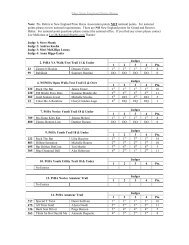2011 Official Rule Book - New England Pinto Horse Association
2011 Official Rule Book - New England Pinto Horse Association
2011 Official Rule Book - New England Pinto Horse Association
You also want an ePaper? Increase the reach of your titles
YUMPU automatically turns print PDFs into web optimized ePapers that Google loves.
1. All courses must be posted at least one hour before<br />
scheduled time of class in a place readily available to<br />
exhibitors.<br />
a. The plan or diagram of the course must show the<br />
obstacles, which must be taken in the order indicated<br />
by numbers.<br />
b. Exhibitor is not bound to follow a compulsory track.<br />
c. An arrow is used to indicate on the plan the direction in<br />
which each obstacle is to be taken.<br />
2. Circling is permitted once upon entering the ring.<br />
3. After jumping the last fence, while still mounted and prior<br />
to leaving the arena, the horse should be trotted in a small<br />
circle with a loose rein to be checked for soundness.<br />
4. <strong>Horse</strong>s shall not be requested to show at a walk, trot and/<br />
or canter or to re-jump the course or any part thereof.<br />
5. The Show Committee should take into consideration the<br />
quality and experience of <strong>Horse</strong>s available in determining<br />
the height of fences for each class (i.e., beginning <strong>Horse</strong>s<br />
use lower fences than more experienced <strong>Horse</strong>s, who<br />
usually will not jump well if the jumps are too low).<br />
6. The premium list must include the exact height of fences to<br />
be jumped in each class (i.e., Fences 3’0”).<br />
B. Course Design<br />
1. A Hunter course shall be a course which management<br />
deems a fair test of a Hunter.<br />
a. Fences shall simulate obstacles found in the hunting<br />
field such as natural post and rail, brush, gate and<br />
chicken coop.<br />
b. Jumps such as triple bar, hog’s back or targets are<br />
prohibited.<br />
2. In handy classes, fences should simulate those found in<br />
trappy hunting country.<br />
a. The course should have at least two changes of<br />
direction.<br />
b. Entries to trot over one fence toward the end of the<br />
course.<br />
c. A ground line is recommended for all fences.<br />
3. Courses shall consist of at least six fences<br />
a. A fence may be jumped more than once if so designed.<br />
b. A course should have no more than ten fences.<br />
c. A course should have at least one change of direction<br />
in all classes.<br />
d. In all 3’3” classes, a combination (in-and-out) should<br />
be included.<br />
4. Distances between fences shall be set as 12’ multiples<br />
(i.e., an in-and-out with one stride between fences would<br />
be 24’; a two stride, 36’).<br />
5. The top element of all fences must be securely placed so<br />
that a slight rub will not cause a knockdown.<br />
a. Fifty percent or more of the fences must be the<br />
required height.<br />
b. None shall be more than 2” over or under.<br />
c. Brush jumps may be lower.<br />
6. The minimum height for any class shall be 2’6”.<br />
7. The maximum height for any class shall be 4’0”.<br />
8. A spread jump is an obstacle or combination of elements<br />
taken in one jump and negotiated in the proper direction.<br />
9. An in-and-out is considered as two obstacles, but must<br />
never be used as a first fence.<br />
C. Judging<br />
1. Performance – An even hunting pace, manners, jumping<br />
style, together with faults and way of moving over the<br />
<strong>2011</strong> PtHA <strong>Rule</strong> <strong>Book</strong> 173<br />
ClassEs



